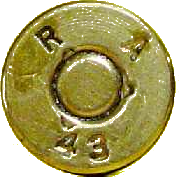Ysterhout Dot Net
There is a paper writen by Richard Ohlsson as his Masters thesis conducted at the Norma factory, on the measuring of the case hardness profile before, during and after what he refers to as annealing.
From the document :
As seen in Table 2, the cases experience two different annealing’s of the neck during the manufacturing processes. The annealing at Norma is made by induction heating where the Win Mag at the first neck annealing is annealed for ca 14 seconds at an induction of 2,8 kW and at the second neck annealing ca 14-15 sec at 6,1 kW. The exact temperatures have not been measured but previous measurements at other cases at Norma Precision AB has shown that the temperatures lie in the range of 350-600°C. From Figure 5, it is seen that annealing at those temperatures does not change the phase of the microstructure for the brass.
The phase referred to is the solid phase, which only changes past 900 degrees C.
Note that the pictures of different brass grain sizes used for illustration in that document are of their extruded blanks after various extrusion operations that were at temperature for 30 minutes. We heat the brass for a few seconds, which is not enough time for annealing to take place.
Section 3.1, Table 2 describes what they do. After each extrusion operation on the billet, it is annealed. This means the entire billet is at a temperature of 400 degrees C for 30 minutes. After the final draw, no more annealing is performed, only the necks are "annealed" twice between the neck forming operations. The annealing referred to between draw operations is a true anneal. The neck anneal is not a true anneal [ total immersion at temperature for 30 minutes ], it is a seconds long stress relief.
For a metal to be annealed, the finer crystal structure must change by a process of re-crystallization under the application of constant heat for sufficient duration into a structure of coarser grain. The annealing process is not instantaneous. Metallic crystals do not habitually blink out of existence and back in having increased size.
Cartridge brass cannot anneal in three seconds. If it was possible, Norma would anneal their cartridge billets between draw operations for three seconds, not 30 minutes. It is impossible to properly anneal the neck of a brass case without the entire case being raised to the annealing temperature.
What can and does does occur in those few seconds is stress relief. Stress relief in thin brass sections can happen almost immediately at sufficient temperature.
Brass has a known peculiarity that we cartridge reloaders have found out recently, but has been known to the metal fabricators and machinists for over 150 years - it gets harder with working. To the point where a piece of brass being worked on a lathe may actually deform itself due to the internal, non-uniform stress matrix being built up in the metal from the machining process. To the point where brass can even deform due to work hardening [ induced strain ] by repeated change in atmospheric conditions.
When we fire a brass cartridge, it is work hardened, or the existing strain matrix has additional strain added to it. This strain matrix is not uniform, resulting in the observed phenomenon of variable neck tension in a batch of brass that is identically re-sized. We do not relieve the stress in the brass towards the case web, although from a metallurgical point of view it is scientifically proven that strain relief does not reduce the mechanical properties of brass. Cartridge reloaders just focus on the case neck, which holds the bullet.
To relieve the strain matrix, we apply sufficient heat to the case neck for a short period, and it has the resultant effect of uniforming the neck tension, or reducing the strain in the metal matrix to the same level across all the cases similarily treated. We know that is is vitally important to heat each case exactly the same way for the exact same period of time for best uniformity. This means that the strain in all the treated brass is reduced to exactly the same level.
This strain relief is not annealing. Annealing is the re-crystallization of the metal matrix after which the internal strain on the crystal structure is zero. Strain relief is the reduction of the strain matrix to a level determined by applying the same temperature to the same area for the same time.



